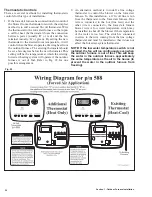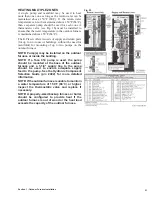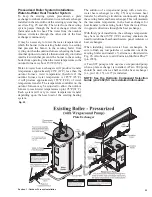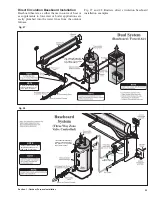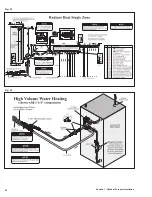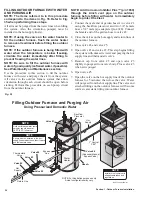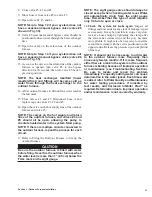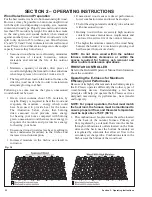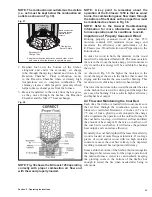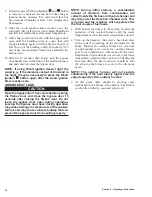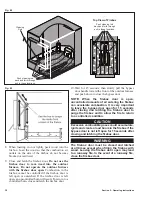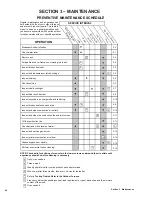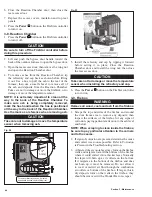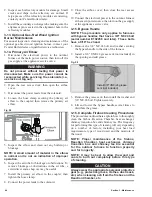
32
Wood Selection and Preparation
For the best results, it is best to burn seasoned split wood.
However, it may be possible to burn some unsplit wood
with the split wood depending on quality, size, moisture
content and wood type. Properly seasoned wood contains
less than 25% moisture by weight. It is darker, has cracks
in the end grain, and sounds hollow when smacked
against another piece of wood. Most wood needs to be
split to dry down to 25% within a year. Wood between
4" and 8" (10 and 20 cm) in diameter works well in most
cases. Pieces of wood that are too large can reduce output
capacity because they burn slower.
• Seasoned wood burns more efficiently, minimizes
the amount of creosote formation, reduces
emissions and extends the life of the outdoor
furnace.
• Maintain a quantity of smaller, drier pieces of
wood for relighting the fire and for other situations
when larger pieces of wood don't work as well.
• The larger the heat load on the outdoor furnace, the
drier the wood needs to be in order to maintain an
adequate glowing coal bed.
Following are some reasons that green, unseasoned
wood should not be used:
• Green wood contains about 50% moisture by
weight. Energy is required to heat the wood and
evaporate the moisture - energy which could
have been used to provide heat for the home.
The illustration below shows that burning
drier, seasoned wood provides more energy
for heating your home compared with burning
green, unseasoned wood that uses more energy to
evaporate the moisture and provides less energy
for heating your home.
• Unseasoned wood provides less heat, resulting in
more condensates (moisture) in the firebox and
increased wood consumption.
• Increased moisture in the firebox can result in
corrosion.
• Unseasoned wood causes reduced performance,
lower combustion rates and lower heat output.
• The full heating potential is unlikely to be achieved
with unseasoned wood.
• Burning wood with an excessively high moisture
content increases maintenance requirements and
can lower the service life of the outdoor furnace.
• The higher the moisture content of the wood being
burned, the harder it is to maintain a glowing coal
bed because it burns more slowly.
NOTE: Do not store wood within the outdoor
furnace installation clearances or within the
spaces required for fueling, ash removal and
other routine maintenance operations.
FIRESTAR CONTROLLER
Refer to the FireStar II Operator's Manual for information
about the controller.
Operating the E-Classic for Maximum
Efficiency and Performance
Because of its highly efficient and clean-burning design,
the E-Classic operates differently than other types of
wood-burning devices. Understanding a few basic
principles will help you operate the E-Classic as it was
designed, maximizing its performance, heat transfer
and longevity.
NOTE: For proper operation, the fuel must match
the heat load, the furnace must be maintained to
ensure proper air flow, and the water temperature
must be kept above 150˚F (66˚C).
1. The combustion air fan pressurizes the airbox located
at the back of the outdoor furnace. Primary air
flow, regulated by a solenoid, flows into the firebox
through combustion air outlets located on the front,
sides and the back, near the bottom. Secondary air
is regulated by solenoids that allow air flow to the
secondary air charge tube. Combustion starts in the
firebox near the bottom of the wood load.
SECTION 2 – OPERATING INSTRUCTIONS
Fig. 36
Section 2 - Operating Instructions
Содержание e-Classic 1450 IR
Страница 17: ...15 Section 1 Outdoor Furnace Installation...
Страница 29: ...27 Section 1 Outdoor Furnace Installation Fig 30 Fig 31...
Страница 30: ...28 Section 1 Outdoor Furnace Installation Fig 32 Fig 33...
Страница 66: ...64 E CLASSIC 1450 WIRING DIAGRAM Section 6 General Information...
Страница 67: ...65 Section 6 General Information E CLASSIC 1450 WIRING DIAGRAM OPTIONAL POWER IGNITION...
Страница 69: ...67 NOTES...
Страница 70: ...68 NOTES...
Страница 71: ...69 NOTES...



